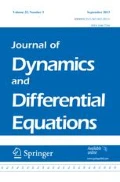1 Correction to: J Dyn Diff Equat (2016) 28:49–67 https://doi.org/10.1007/s10884-015-9510-6
The original version of this article, unfortunately, contained an error.
In [1], we studied
for \(\Omega = (0,L)^d\), \(d=1\) or \(d=2\) with periodic boundary conditions. The nonlinearity had the following form,
where \(\alpha , \beta >0\) are anisotropy coefficients.
The way to obtain long-time results was through the study of the differentiated system (1), \(u=\nabla h\), i.e. we differentiated (1) with respect to x. Here is the resulting problem,
where \(u = (u_1, u_2) =(h_x, h_y)\) (resp. \(u= h_x\)), if \(d=2\), (resp. \(d=1\)).
We proved in [1] the following result about (2).
Theorem 1
([1, Theorem 4], [1, Theorem 5]) Let us consider \(\Omega =(0,L)^d\) with \(d=1,2\) and \(L>0\) arbitrary. The semigroup \(S(t):\dot{H}^2_{per}(\Omega ) \rightarrow \dot{H}^2_{per}(\Omega ), u_0 \mapsto S(t)u_0 = u(t) \) generated by equation (2) with periodic boundary conditions has a global attractor.
We also claimed that the following result holds true.
Theorem 2
([1, Theorem 6]) The semigroup generated by equation (1) has a global attractor in \(H^3_{per}\) for \(d=1\) and \(d=2\).
However, this claim is not valid, because if h is solution to (1), then due to [1, Lemma 13] we know that \(\nabla h\in L^2(0,T; \dot{H}^5_{per})\) and integration of (1) over \(\Omega \) yields,
However, \(\frac{d}{dt} \int _\Omega h (x,t)\,dx = 0\) if and only if \(h\equiv const.\) Moreover, \(h = const.\) is a steady state of (1). As a result, if h is not a constant steady state, then
This fact was overlooked in [1], making the claim in Theorem 2 invalid.
Reference
Korzec, M.D., Nayar, P., Rybka, P.: Global attractors of sixth order PDEs describing the faceting of growing surfaces. J. Dyn. Differ. Equ. 28, 49–67 (2016)
Author information
Authors and Affiliations
Corresponding author
Additional information
Publisher's Note
Springer Nature remains neutral with regard to jurisdictional claims in published maps and institutional affiliations.
Rights and permissions
About this article
Cite this article
Korzec, M.D., Nayar, P. & Rybka, P. Correction to: Global Attractors of Sixth Order PDEs Describing the Faceting of Growing Surfaces. J Dyn Diff Equat 32, 1577–1578 (2020). https://doi.org/10.1007/s10884-019-09771-0
Published:
Issue Date:
DOI: https://doi.org/10.1007/s10884-019-09771-0

